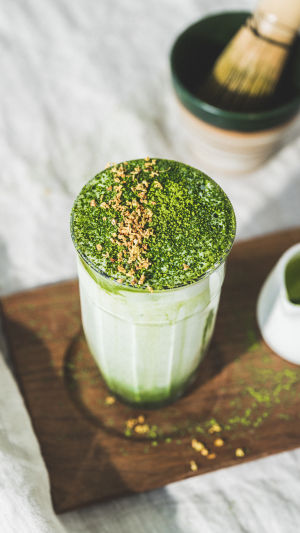Matcha, a type of green tea originating from China, has undergone a transformative journey through Japan's distinctive production process.
Beyond its significant role in traditional tea ceremonies, matcha has found its place in the global tea market.
Among the various expressions of matcha, the drinking culture represented by matcha beverages has become an integral part of many individuals' daily lives.
1. The Art of Crafting Matcha
1.1 Harvesting and Selection
The process of crafting matcha begins with the careful picking of tea leaves. To produce high-quality matcha, it is essential to select tender green tea leaves cultivated in a cool environment.
These young leaves undergo meticulous screening post-harvest to ensure that only the most delicate and tender ones are chosen for processing.
1.2 Steaming and Drying
After harvesting, the tea leaves undergo a steaming process to prevent fermentation, preserving their original color and taste. Subsequently, the leaves are spread out to dry, maintaining the optimal humidity level.
1.3 Stone Grinding
The dried tea leaves undergo a precise stone grinding process, gradually transforming into a fine powder. This step is crucial in determining the fineness of matcha particles and the richness of their flavor profile.
2. Distinctive Flavors of Matcha Drinks
2.1 Matcha Latte
Matcha latte, a delightful combination of matcha and milk, offers a harmonious blend of milk's richness and matcha's aromatic intensity, resulting in a nuanced and layered taste. The key to preparing a perfect matcha latte lies in achieving the right milk temperature and finely textured milk foam for a well-balanced flavor.
2.2 Matcha Ice Cream Milk Tea
The fusion of matcha with ice cream and milk tea gives rise to a refreshing and layered beverage. The sweetness of the ice cream intertwines with the subtle bitterness of matcha, creating a unique taste experience—a perfect choice for cooling down during the scorching summer months.
2.3 Matcha Latte Smoothie
A refreshing summer indulgence, the Matcha Latte Smoothie seamlessly combines the essence of matcha latte with the invigorating qualities of a smoothie.
This beverage retains the aromatic notes of a latte while introducing the refreshing taste of a smoothie, making it a popular choice for beating the summer heat.
3. Cultural Significance of Matcha Drinks
3.1 Traditional Tea Ceremony Culture
Integral to the traditional Japanese tea ceremony, matcha emphasizes etiquette, tranquility, and respect. Beyond a simple act of tea consumption, preparing matcha in a tea ceremony is a spiritual ritual—a way to calm the soul, connect with nature, and embrace a unique way of life.
3.2 Modern Innovation Culture
In modern society, matcha drinks serve as a bridge between tradition and innovation. A growing number of innovative beverage outlets are experimenting with matcha, combining it with diverse flavors to attract a broader audience.
This not only diversifies matcha drinks but also contributes to the continued evolution of matcha culture.
3.3 Art and Taste
The distinctive aroma and taste of matcha are regarded as an art form. Tasting matcha drinks is not merely a sensory delight; it is an artistic journey. Each sip is akin to experiencing an abstract painting, where one discovers a profound and serene beauty.
In conclusion, matcha drinks, with their unique production techniques, diverse flavors, and rich cultural significance, stand out as a radiant gem in the global tea market.
Whether one seeks a traditional tea ceremony experience or indulges in modern, creative matcha beverages, matcha has captivated tea enthusiasts worldwide with its distinctive charm.
Matcha drinks are not just a choice of taste; they embody a delightful journey of savoring life and appreciating culture. Let us immerse ourselves in the tranquility and beauty encapsulated in the aroma of a cup of matcha.





